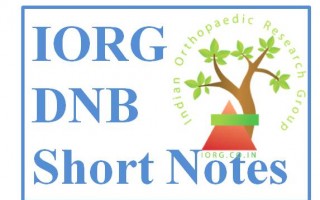What is a Discoid Meniscus?
It is an anatomic congenital anomaly presenting with abnormally shaped and thickened meniscus that completely filled-in and covers a greater area of tibia condyle. There may or may not be a central opening. It is almost always on the lateral side, higher incidence in Asians
How do you classify Discoid Meniscus?
Watanabe classification: three types based on meniscal shape and attachments
Type I – Incomplete
Type II – Complete
Type III- Wrisberg.
The complete and incomplete differ only by amount of coverage of tibial condyle with type I covering it incompletely (<80%) and type II covering it completely. The complete type is most common and is more prone to tears. Wrisberg type is hypermobile due to deficiency of posterior attachment to the tibial plateau except that the posterior meniscofemoral ligament [Wrisberg ligament] is intact. Thus this single ligamentous attachment tethers the otherwise hypermobile meniscus limiting the forward glide. This gives the characteristic palpable snapping or clunking which results from the reduction of an anteriorly subluxated meniscus.
How is diagnosis of Discoid meniscus confirmed?
MRI is investigation of choice to confirm the diagnosis of discoid meniscus. Discoid meniscus if defined as meniscus that meets one of the following three criterias: three or more consecutive 5mm sagittal sections showing continuity between anterior and posterior horns, a transverse meniscal diameter of 15mm or a width of >20% of the normal tibial width on transverse images. A characteristic ‘bow-tie’ appereance can be seen on sagittal MRI
What is clinical presentation of discoid Meniscus?
Depending on the stability of the meniscus the presentation differs.
-Unstable or hypermobile variety presents with pain, popping, snapping and decreased ability to extend the knee. Joint line tenderness, locking, giving way joint effusion and quadricep atrophy may be associated. The onset of these is generally in childhood between 5 to 10 years of age.
-Stable variety generally presents acutely with meniscal tear with pain, locking, inability to bear weight and other symptoms of normal meniscal tear.
What is the treatment for Discoid meniscus?
Treatment only for symptomatic cases
Occasional snapping with minimal pain requires no treatment just patient education
Current treatment modality of choice is arthroscopic debridement, partial meniscectomy to reshape the meniscus (saucerization), and repair of the detached or unstable fragments. Saucerisation involves reshaping the meniscus into normal C shape of the meniscus. To prevent the risk of recurrent tearing, a rim of 6mm is to be retained in complete stable meniscus and a rim of 8 mm to be kept in cases of incomplete unstable meniscus.
What Are the Emergencies in Orthopaedics?
1- Open Fractures
2- Irreducible dislocations of major fractures
3- fractures with deep laceration or excoriation in the operative field
4- Spinal injuries with neurological deterioration
5- fracture/dislocation that impair vascularity
6-fracture with compartment syndrome
-[Campbell]
What is the difference between Pins, Rods and Nails?
The difference between these implants lies in the biomechanical force they can resist
Pins -resist deviation in alignment only
rods-resist deviation in alingment as also Translation
Nails-resist deviation in alignment, Translation and rotation
How to clinically differentiate osteiod osteoma with osteoblastoma?
Three clinical factors diffentiate these. Diurnal variation of pain, relief by NSAIDS and presence of radiculopathy. In osteoid osteoma there is diuranal variation of pain which is relieved by NSAIDS and radiculopathy is very rare. In osteoblastoma there is no diurnal variation of pain, pain is not relieved by NSAIDS and radiculopathy is more common due to expansible lesion. Also clinical scoliosis is more commen in Osteoid osteoma, although it is rather a function of duration os the disease than the diagnosis.
What is the differential diagnosis possible causes of acro-osteolysis?
connective-tissue disease: scleroderma / /Reynaud's
/dermatomyositis
psoriatic arthritis
Reiter disease
juvenile chronic arthritis (JCA/JIA)
frostbite(thumbs spared)/burns
leprosy/DM
polyvinylchloride exposure
ergot poisoning
hyperparathyroidism
Lesch-Nyhan syndrome (they bite 'em off)
cleidocranial dysostosis
progeria (check Amitabh Bachchan!!!)
pyknodysostosis (aplasia/hypoplasia of distal digits)
sarcoidosis
epidermolysis bullosa
Familial (Hadju-Cheney syndrome)
( Contributed by Dr Aditya Maheshwari)
Define Posture?
Relationship of parts of the body to vertical line passing through the centre of gravity.
Or
Attitude of the person in which he stands, sits or lies down.
(Dr Rajeev Joshi)
Define Posture?
Relationship of parts of the body to vertical line passing through the centre of gravity.
Or
Attitude of the person in which he stands, sits or lies down.
(Dr Rajiv Joshi)
What is Ortolani’s test?
It is a test used to diagnose congenital dislocation of the hip
Who originally described Ortolani’s test?
Ortolani’s test is first described by Le Damany in 1914 in an article published in American journal of Orthopaedics named ‘Congenital Luxation of the Hip.
How to perform Ortolani’s test?
The baby should be placed on a firm surface and should not be crying or agitated (Should be relaxed). One hand is used to stabilise the pelvis and thigh while the other hand holds the thigh in a grip formed by thumb on the knee and long and index finger on the trochanter.
Step I – Flex the hip to 90° and then start abducting and simultaneously pushing the femoral head by the index finger to lift it into the acetabulum. Clunk of entry is heard
Step II- Adduct the Hip and feel the hip dislocating out of the acetabulum with a clunk of exit.
False Negative for Ortolani Test?
The test may be negative in cases with bilateral hip dislocations or in cases with antenatal in utero dislocation.
How to Differentiate Click and Clunk?
A click is caused elastic snap of either ligamentous or myofacial tissues like iliotibial tract or gluteal muscles or may be by vacuum phenomenon in the hip joint [akin to that when we flick our finger joints]. It is a high pitched sound.
What is the aim of Barlow’s Test?
This test is performed with the aim to determine if the hip is dislocatable
How to perform Barlow’s Test?
Baby supine on a firm surface. Untested hip held at 90° flexion and 45° abduction. Hip to be tested is held in 45° flexion and 5-10° adduction. The thigh is held with thumb over the medial aspect of knee and long and index finger over the greater trochanter.
Step I - Femoral head is then pushed posteriorly and laterally in an attempt to dislocate the hip. If the Hip is Dislocatable, the femoral head slips out of acetabulum with a clunk of exit.
Step II – The posterolateral force is released and the hip is gently flexed and abducted. This will relocate the femoral head with a clunk of entry.
What is the difference between Ortolani’s Test and Barlow’s Test?
Ortolani’s Test diagnoses a already dislocated hip while Barlow’s test indicates an unstable dislocatable hip
During Ortolani’s Test the Clunk of entry in first followed by clunk of exit, while in Barlow’s test the clunk of exit is followed by clunk of entry.
What does Extension LOOSENESS of the hip in newborn indicate?
Normally due to intrauterine positioning the newborn baby has flexion contractures of knee and hip joints [15-20°] which disappear normally by 2 to 3 months. When there is congenital dislocation og the hip, the hip and the knee can be extended fully or even hyperextend. This looseness is a very strong sign of hip dislocation.
What is the basis of Thomas Test?
In cases with flexion deformity, hip extension is lost and thus while walking or standing the foot cannot reach the ground. To make the foot reach the ground, pelvis tilts anteriorly in Saggital plain. This in turn causes increased Lumbar Lordosis as compensation. In Thomas test this pelvic obliquity is reversed by taking into account the lumbar lordosis and the residual hip flexion deformity is revealed.
What constitutes a Horner’s syndrome?
- Triad of Ptosis, miosis and anhydrosis
- there may be apparent enopthalmus and lag in pupilary dialatation
- Johann Friedrich Horner was a talented and well-respected 19th-century Swiss ophthalmologist. In 1869, he described a 40-year-old woman with headaches who had a right droopy eyelid, smaller right pupil, and right facial flushing.
- Because the French physiologist Claude Bernard described the signs of sympathetic injury in animals 17 years earlier in 1852, the syndrome is also called Bernard-Horner syndrome in some parts of the world













 India-Orth
India-Orth